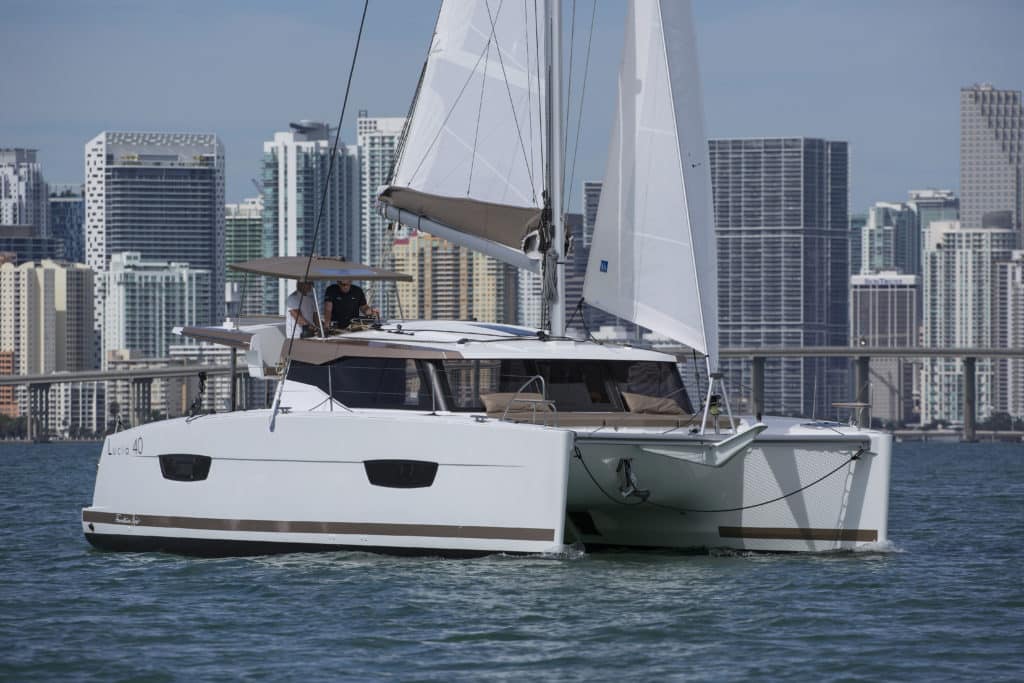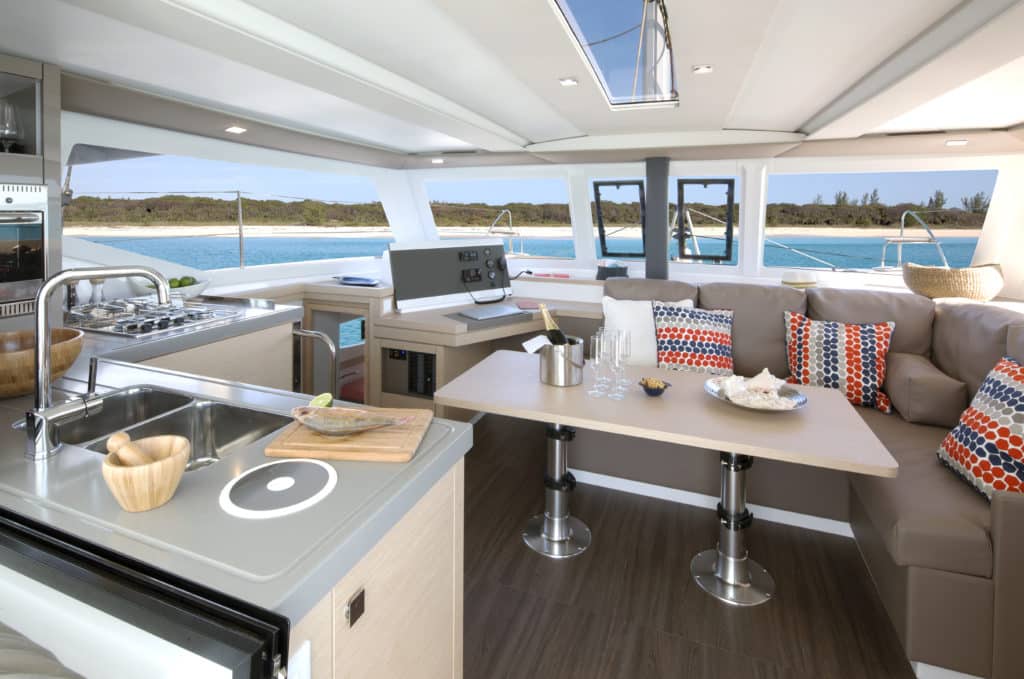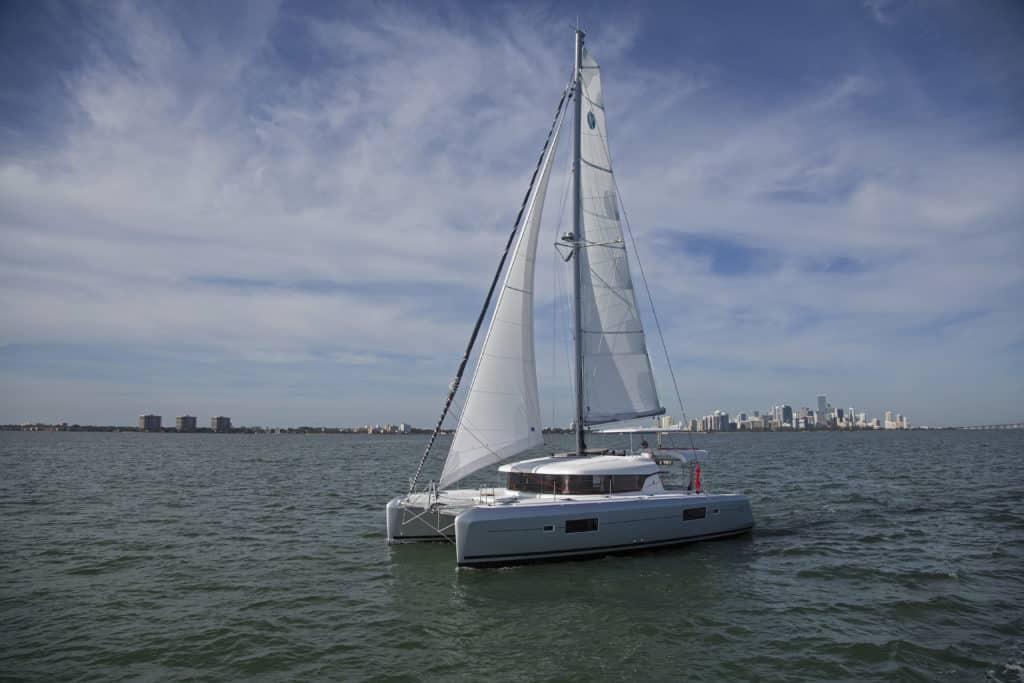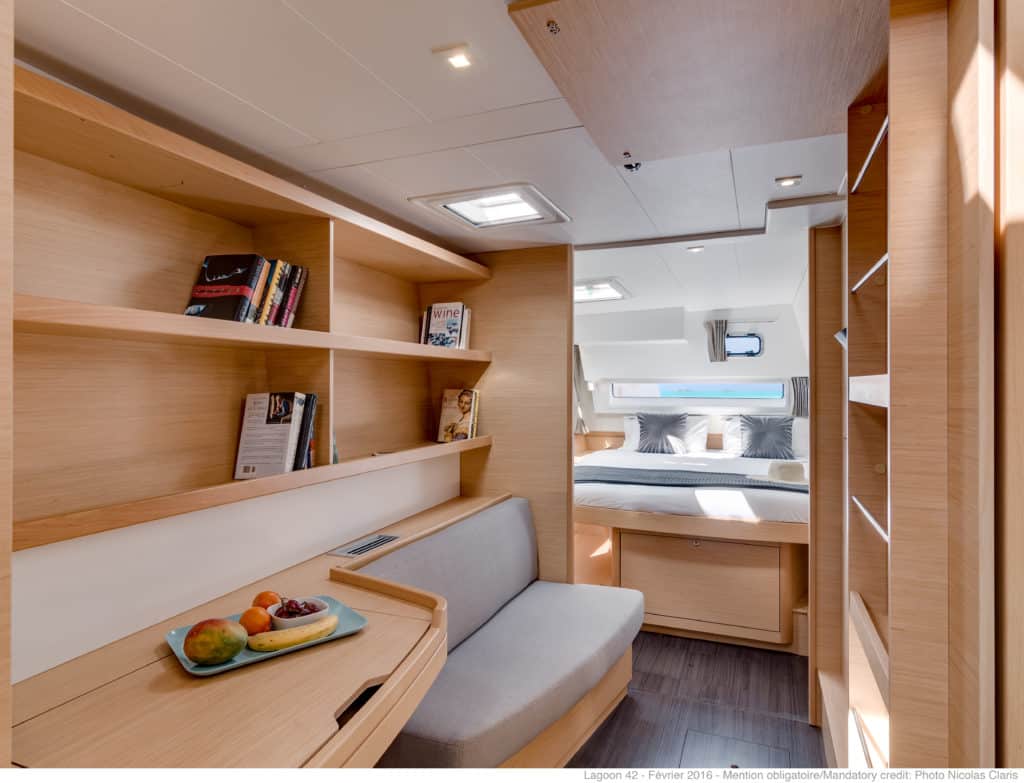The day began inauspiciously. Cracking the curtain of my hotel window in downtown Miami — directly across the street from Miamarina at Bayside, the site of last winter’s Strictly Sail Miami Boat Show, which had concluded the evening before — I had a fine view of the sideways rain pelting the rush-hour traffic on Biscayne Boulevard, the leaden skies hanging low and ominously over the neighboring high-rises, and the occasional flash of distant lightning.
It was a perfect morning for pulling up the covers, ordering room service and renting a movie, none of which was on my agenda. Nope, I had different plans. I was going sailing.
Over the years, I’ve lost track of the number of boats I’ve tested and reviewed, though I’m certain I put the hundredth in my wake many moons ago. Most of the time, the boats are neat and it’s a blast. In some instances, the vessels are ill-prepared and not ready for prime time, or the breeze fails to materialize, and it’s either boring or an ordeal (and sometimes both). Rarely does the weather devolve to the point where the whole exercise becomes dodgy and dangerous, but it does happen. Even at the worst moments, however, I count myself lucky: Not everyone gets paid to put flashy new boats through their paces.
In any event, as I stuffed my backpack with notepads, cameras and foul-weather gear, on this morning I had no clue how the day would transpire, other than that I had scheduled two test sails aboard a pair of French cats that had made their American debuts at the show a few days earlier: a late-morning session on the Fountaine Pajot Lucia 40 and an afternoon appointment aboard the Lagoon 42. The radar app on my smartphone confirmed the TV weatherman’s forecast: The current line of thunderstorms was quickly moving off the Florida coast, with clear skies to follow. What the wind would do, if anything, was an entirely different matter.
Cautiously optimistic, I downed breakfast and headed over to the marina. Little did I know that one of my cooler, more agreeable days of boat reviewing was about to unfold.

Lucia 40:
The Owner
The sky had cleared and bright sunshine was drying the still-damp docks as I made my way down a pier to rendezvous with the crew of the Lucia 40, who’d just tied up after an earlier test sail with several of my fellow scribes from other sailing magazines. (I like my colleagues but avoid group boat tests whenever possible; I prefer to have the undivided attention of the builder or their representative so I can ask stupid questions free from embarrassment.) It was pretty clear from their expressions, which were as limp and still as the drooping flags on the dockside displays, that their outing had not been an exhilarating experience. “Good luck,” said an old writer friend as we passed each other. “There’s not a breath of air out there. It’s flat calm.”
Another cardinal rule of boat reviewing — though this too is sometimes unavoidable — is to never test a brand-new boat with its brand-new owner. I know it’s hard to believe, but some new owners have reservations when I ask to set the spinnaker or shake out a reef in building breeze, or to roll their lovely vessel into a death turn under power at 2,800 rpm. Go figure.
So I was a little taken aback when I stepped aboard to shake hands with Steve Clawson, the justifiably proud owner of Love Knot, hull number two of the Lucia 40 line. Steve in turn introduced me to a pair of strapping young bucks from Annapolis, Maryland, where the boat was bound after Miami. Clearly, these lads weren’t Frenchmen from Fountaine Pajot; in fact, there wasn’t a company rep in sight. It appeared it would be the four of us. Steve asked if I was ready to go sailing. Mate, I was born ready.
I’d already taken the opportunity to poke around the Lucia 40 earlier, during the show. Visually and stylistically, the Olivier Racoupeau design has a lot going on. In profile, the hulls feature aggressive plumb bows and reverse sheer lines that rise unexpectedly amidships before tapering aft into what look like reverse transoms but are actually pronounced outer rails for the two sets of transom steps (with a swim ladder on the starboard set). A solid canopy that also hosts the beam-width traveler on its aft edge caps the cockpit. A pair of portlights in each hull pour natural light into the staterooms below and accent the wraparound coachroof windows. With the clear objective of maximizing space, every item on the boat appears to have been given a lot of thought.
As on many modern cats, a sliding-glass door and drop-down window separate the cockpit and the main cabin; when everything is opened up, the two distinct areas merge into one open floor plan. Naturally, the centralized L-shaped galley straddles the cockpit and the saloon, putting the cook squarely in the middle of everyone and everything. A big L-shaped settee opposes the galley and shares a seat corner for the desk and navigation station. Spatially, these bookend features are both functional and fun. From the inside looking out, the coachroof windows offer arresting views.
To port, down four steps, the boat sports staterooms fore and aft with inviting double berths and private heads. But it’s the owner’s suite to starboard — in what Fountaine Pajot calls the Maestro layout — that’s arguably the nicest spot on the cat. A desk and vanity in the middle of the cabin are sandwiched between a large double berth aft and an enclosed head, with a huge dedicated shower stall forward. It’s a terrific layout.
As we motored out of the marina, bound for Biscayne Bay, Steve handed over the helm to his professional delivery skipper, Jordan Peacock, and we repaired to the trampolines for a good old gam. I found Steve’s personal sailing story every bit as intriguing as his new ride.
Having grown up on a landlocked farm in Indiana, when it came time for college, Steve was eager to see both the water and the world. A commission to the United States Naval Academy in Annapolis provided an avenue to both.
Though he’d fussed around with small boats on Midwest lakes, at the Academy he truly learned to sail, and a posting to a Puerto Rico duty station at the outset of his career provided the opportunity to purchase his first boat, a 20-foot wooden sloop aboard which he happily explored the nearby Spanish Virgin Islands.
For many years after, constant moves made boat ownership impossible, though he continued to hone his skills at Navy sailing clubs when posted to bases in Newport, Rhode Island, and other locales. By 2008, having retired from the Navy and working as a consultant based near Annapolis, he was ready to again take the ownership plunge and bought a locally built Gemini catamaran from Performance Cruising.

Though most of his sailing had been in monohulls, Steve; his wife, Luz Marina; and their family loved the space of the cat and the fact that they could take novice sailors and kids out on Chesapeake Bay with no worries. But he was also thinking about a bluewater boat he could cruise farther afield. And while he’d chartered boats frequently in the Caribbean over the years, including many monohulls, some of his best trips had been aboard Fountaine Pajot cats like the Mahé 36 and Bahia 46. At the Annapolis Spring Sailboat Show in 2015, he saw the drawings of the company’s new Lucia 40, and a week later he put down a deposit for one of the first to come off the line.
A trip to last winter’s Paris Boat Show, where hull number one was unveiled, and a coinciding visit to the Fountaine Pajot yard in La Rochelle to see his own boat under construction — he’d toured countless manufacturing facilities over the years, and was impressed by the craftsmanship, the cleanliness and the quiet, all of which he likened to an art studio — convinced him he’d made the right choice. That was confirmed when the boat arrived in Fort Lauderdale and, with Jordan and a third hand, he sailed the boat across the Gulf Stream and back in heavy weather and big seas for a photo shoot in Bimini. The Lucia 40 handled her maiden voyage with aplomb, recording nearly 12 knots of boat speed in 25 knots of breeze.
Now, out on Biscayne Bay, the gently ruffled waters signaled the impending arrival of a fresh sea breeze. Nice. We put the throttle down to motor out and greet it. Like most new owners have, Steve had upgraded the twin Yanmar 20-horsepower diesels to the 30-horsepower options, and we skidded along nicely at 6.3 knots at 2,100 rpm and 7.3 knots at 2,800 rpm.
The breeze wasn’t howling, but with a steady 6 to 8 knots, we had enough to go sailing. The big, fully battened square-top main was hoisted with the aid of a Lewmar electric winch — who doesn’t enjoy push-button sailing? — and once the genoa was unfurled, we began tacking upwind at over 5 knots, making good progress considering the light air.
With all lines led to the raised helm station (including a clever continuous line setup for the traveler, the most important trimming tool on any performance cat), nicely shaded by a dedicated bimini, the Lucia was simple and easy to operate, with a light helm. After a while, I turned it over to Steve with exquisite timing as photographer Billy Black picked the ideal moment to wheel alongside in his photo boat. Everyone else dashed below and hid so Billy could nab some hero shots of Steve in command, alone on his boat.
So much for my rule about test sails with owners: Steve’s happiness was infectious. And he hopes to share that joy with other sailors in the future by offering the boat for charters on Chesapeake Bay and in the Virgin Islands, depending on the season (see loveknot-sailing.com). Anyway, the combination of boat and crew couldn’t have been lovelier. Those morning showers were a distant memory.

Lagoon 42:
The Builders
If my midday Lucia 40 sea trial was a mellow stroll in the park, my afternoon Lagoon 42 excursion was an enjoyable scramble up a tall peak. Such are the differences between a light-air foray under main and jib and a full-on test of a complete sail inventory in punchier breeze with a couple of professional rock-star French sailors.
I’d had the distinct pleasure of sailing with Lagoon’s director, Yann Masselot, on several earlier occasions, but this was my first outing with Olivier d’Enquin, a bundle of kinetic energy who works in France handing over new Lagoons from the boatyard to their eager new owners. Obviously, the job requires a talented, supportive sailor. Apparently, neither Yann nor Olivier had yet sailed the 42, which had been rushed to Miami on a freighter just in time for the boat show. And they were very anxious to put her through her paces. (Quick aside: It takes confident builders to share their inaugural sail on a new design with an inquisitive sailing journalist just dying for something calamitous, or rather, interesting to happen.) They also had a couple of crisp new reaching and running sails they hoped to check out. Would I mind?
Why, not at all, mon amis. Let’s get this party started.
As with the Lucia, I’d had a thorough tour of the Lagoon during the show and come away impressed. Perhaps more than any other cat builder, Lagoon has achieved a consistent look across the brand with its distinctive coachroof treatments — specifically the tinted, wraparound, turretlike windows and overhanging eyebrow. You know a Lagoon when you see one.
Yet with the 42, the yard has also pulled off a pretty difficult achievement by producing a yacht that looks reassuringly familiar but is in fact brimming with fresh, innovative ideas. For example, there’s been a concerted effort by naval architect Patrick Le Quément, in collaboration with VPLP design, to create spaces that flow naturally from one to the next, making the simple act of moving about the boat effortless and intuitive. From the low, suspended teak transom steps; to the two series of steps up from the cockpit to either the raised helm station, to port, or the wide, clear side decks; to the three steps that lead from the “winch station,” adjacent to the wheel, to the coachroof platform, which is home to both a daybed and a trio of flat solar panels, the 42 is a boat that practically invites you to roam around.
As with other recent Lagoons, the entire sail plan and rig have been shifted aft, which opens up the foretriangle and the option to set any number of downwind sails. This translates to a shorter boom, but that’s compensated for with the full-battened square-top main. Combined with the standard self-tacking jib, the working sails have plenty of drive yet are easily managed.
In the accommodation plan, the builder’s major theme was maximizing living space by utilizing the full beam and pushing things outward as much as possible, including in the main cabin and the staterooms in the hulls. That trend is especially noticeable in the spacious main cabin, where the settees, cabinets and counter space are all maxed out to the picture windows; in the five gradual steps that lead to the owner’s stateroom, to starboard; in the stateroom itself, where the extra space is utilized for access to the large double berth; and in the lockers, seat and shelves in the stateroom’s centralized desk and settee.
When I arrived at the Lagoon in midafternoon, Yann was noticeably antsy. Let’s just say that the show workers charged with breaking down the docks and finger piers had not been in any particular hurry, and Yann and Olivier were extremely ready to break out of the corral and gallop into the open range. About a nanosecond after the last offending pier was moved, we were underway, with dispatch. It felt like a jailbreak.
“Where to?” Yann asked. We had two choices: motor out of Government Cut and into the open Atlantic, or retrace my earlier steps on the Lucia 40 by heading back under the Rickenbacker Causeway and into Biscayne Bay. I had no idea if there was wind in the ocean but was sure about the bay, so suggested the latter. There was only one problem: The mast on the Lagoon is 68 feet tall, we weren’t entirely sure about the causeway clearance, and the chart plotter was not yet loaded. So I hailed photographer Billy Black on the VHF, and after double-checking his charts, he reported that the bridge was 78 feet high. No worries.

Except that, as we made our approach, the distance between the top of our stick and the bottom of the causeway sure didn’t look like 10 feet. Yann shot me a glance, and I shrugged in return. At which point he put the dual throttles down. “If something happens, we can always blame Billy,” he said. Luckily, we made it under unscathed.
And there was more good news: The breeze had built a bit more and was locked in at 10 knots — still a little light, but pretty darn good. After powering into clear water, making 7.4 knots with the twin 57-horsepower Yanmars at 2,000 rpm and 8.7 knots at 2,400 rpm, in seconds flat my talented, capable crew hoisted the main and unfurled the self-tacking jib, and we shut down the engines. The silence was golden.
Tacking through about 100 degrees, closehauled on starboard tack, we easily clocked along at better than 6 knots. Oddly, on port tack, we couldn’t quite register the same speed, making 5.7 knots. I’m guessing the rig still required a little tweaking on this inaugural sail.
Cracking off, in went the jib and out came the code zero, a sweet, perfectly cut Mylar sail set off a dedicated sprit that immediately gave us a nice burst of speed, with the 42 skimming across the bay at just under 8 knots. Hard on the breeze, you wouldn’t want to fly the code zero in any more wind (though you could certainly crack off with it), but it was just perfect for the fine conditions.
But Yann and Olivier weren’t finished. After our trials, they too were planning on sailing to Bimini for a photo shoot (they’d have the same boisterous conditions as the crew on the Lucia did, and at one point had the 42 scooting along at better than 16 knots), and they had one more sail they’d like to set, a whopper of an asymmetric kite. Did I want to check it out? Gentlemen, knock yourselves out.
It went up without a hitch, and after a couple of jibes, we were soon joined by a big group of Lagoon personnel and prospective clients enjoying an outing on the Lagoon 630 MY power cat. By this time we’d spun around and were heading back to the marina by way of the Rickenbacker Causeway. I was quite enjoying my time at the helm when Yann gave me a nod. I understood exactly what he meant. Did I want to sail under it?
Now, I had a general sense that this might not be an entirely legal maneuver. And the fact that there was a large audience in a huge cat right on our hip was kind of daunting. So too was the perception that the beam of the 42 was not appreciably smaller than the span between the bridge’s central piers. For this test, a writer from another magazine had joined us. She seized the moment to helpfully interject a vote of confidence: “OK, pressure’s on.”
I’ll credit the Lagoon 42’s effortless tracking and pinpoint steering for permitting us to pass through uneventfully. Once safely clear, the power cat sidled alongside and passed over a few ice-cold beers. Their timing was wonderful; in all the excitement, my mouth had become very dry.
We’ll be revisiting both the Lucia 40 and the Lagoon 42 this fall, during our 2017 Boat of the Year tests. I have a strong sense both boats will be solid contenders. As I gathered my things and headed back to the hotel, I couldn’t recall conducting two tests where the weather and venue had been so similar but the actual experiences so different. If only every day at the office, I thought, were just like this one.
Herb McCormick is Cruising World’s executive editor.








